The Mowag Shark is an armored personnel carrier produced by the MOWAG Motor Car Factory, Kreuzlingen, Switzerland. It stayed at prototype stage. It was originally a heavy weapons carrier, replacing conventional tracked battle tanks still possessed by Switzerland at the time. It is the little known development of the Piranha 1, equipped with front and rear axles steering, whereas the two middle axles stayed unsteered to achieve a tight turning circle at 12.5 m. The suspension on the first and fourth axles had independent suspension with conventional spring strut, and built-in shock absorber, while the second and third axles had independent suspension with torsion bar springs and external shock absorbers to maximize internal space above all. It was was tested in Switzerland, Germany and Canada, also with a wide variety of weapons, the base model having an Oerlikon 30 mm GDD-BOE turret, Germany testing the Rheinmetall RH 105-11 turret and an anti-aircraft turret with twin 35 mm Oerlikon. The basic APC jad no external armament. In all cases, the layout resembled the Piranha, with the driver and commander sitting next to each other, angine a the rear. Only three prototypes were built in 1981, one now presrved at the Swiss Military Museum.
The Mowag Technical Division led by August Granwehr proposed in 1978 to the direction a successor to the Piranha, capitalizing on what was learned from the failed Puma. The Shark started as a larger, buffier Piranha 8x8, keeping the same same profile. The direction greenlight the construction of two prototypes, the first being completed in September 1981 with trualed made in the winter of 1981-82 and spring. By May 27, 1982, the Shark 8x8 was officially presented at Unterlüs in West Germany, jointly with Rheinmetall, on June 23-24 at Elm in Switzerland with Fives-Cail Babcock for a different turret. Two more prototypes were completed and Mowag by July 1983 announced it was ready to launch mass production to answer any order.
At first the vehicle was presented as a tank destroyer but like the Piranha it stayed a multipurpose platform, ready to receive multiple weapon systems and negociate the most difficult terrain to adapt to a fast evolving tactical situation. Despite its size, the basic vehicle weighted 16 tons. Depending on the chosen version, it could go up to 25 tonnes and more.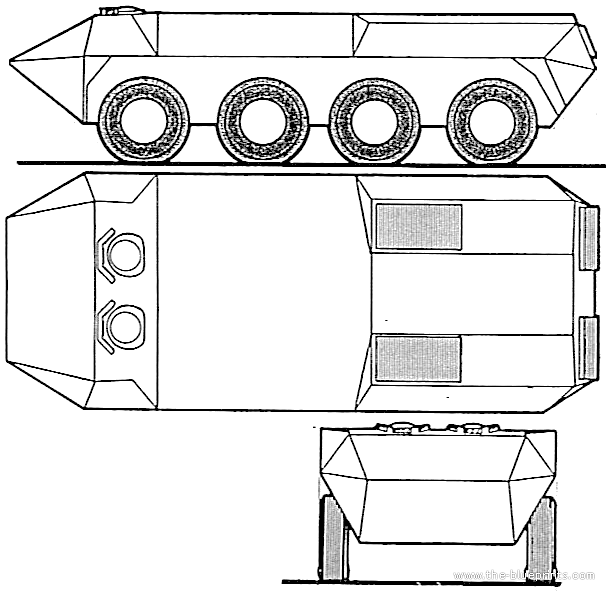
The hull of the MOWAG Shark like the Piranha was in all-welded steel and tailored to protect the crew at any angle against the standard Soviet 14.5 mm KPV AP round or shrapnels from a 155 mm HE projectile landing 10 meters away. The driver is in the nose, left with a single-piece hatch cover and three periscopes, with the central one swappable for an IR periscope. There was a second seat at his right, a space free for an NBC pack or additional ammunition. The central fighting compartment could accept a large number of weapons platforms. The engine and transmission as well as the fuel tanks are located at the rear with air inlet louvers on either side. Powered steering was at the front. NBC system remaine doptional as well as moke projectors, but fire-extinguishing systems are in serie. The armour in RHA steel protected at all angles against 14.5 mm AProunds, but the angular armour could be reinforced by spaced armor. Its silhouette can stay llow depending on the weapon station mounted, the best being for this, the FL-12 turret.
Weight distribution was done to provide a center of gravity at 1.25 m high from the ground (frame between 2nd and 3rd axles). The suspension was borrowed from the Piranha, with independent wheels, oversized coil springs, hydraulic shock absorbers, the latter only the outer steering wheels. The wheels are mounted on swing arms with hydraulic shock absorbers. Vertical move range is 420 mm, 100 mm more than on the Piranha. The steering is hydraulically assisted for a tight turn and circle. The Shark had a remakable acceleration, 500 m in 33 seconds and was tested on the worst terrains up to 80 km /h, overcome 60% slopes, helped by a ground clearance of 0.46 m.
The Track is 2.62 m wide for each axle, the wheelbase comprised a gap of 1.51 m then 1.4 m then 1.49 m between axles. It had 40°/45° angles for approach/departure. The vehicle can ford 1.3 m, but is not amphibious. It could negociate a side slope of 35%, a vertical obstacle of 0.46 m gap a trench 2.3 m wide. For Brakes, they used a dual circuit, hydraulic and air assisted. Parking brake uses a spring-loaded brake cylinder and the engine brake the Jacobs system. The Shark also came with the 24 volts electrical system.
-Anti-aircraft: Wildcat twin 30 mm SPAAG
-SPAAML with the French Crotale (missile), two quad launchers plus tracking radar
-Swiss Air Defense Anti-Tank System (ADATS) missile system.
-Anti-tank (including missile)
-Fire support (low recoil 105 mm gun)
-Reconnaissance (same)
-Rocket launcher (developed on paper only).
The most marketed version was at first the early prototype with a French FL-12 turret with a French 105/44 mm CN-1 05-57 cannon. It was compatible to both NATO and French ammunition and was aimed at replacing the AMX-13 in countries having these as reconnaissance unit. Needless to say the Shark was much, much faster. It was also marketed to the French Army in order to replaced the AMX-13 and this turret was first intended to modernize it, retaining all its effectiveness. It now included hollow charge, fin stabilized ammunition and AFPSDS. The gun and turret were in fact already chosen by Steyr-Daimler-Puch for its Panzerjager SK105 Kürassier.
The oscillating turret was light and very compact, enabling to mount a heavy gun on a relatively small ring mount, but it had drawbacks as well, notably for NBC protection. The turret had seven Sopelem L- episcopes 794B (commander) and two L794D (gunner) plus the main gunner sight Sopelem SOPTAC 18-04, daytime system combining a M-213 aiming scope (x7 magnification) and Cilas TCV107 laser rangefinder (10 km), precision of ± 5 m. There was also an IR episcope and the Sopelem TN2-12 light intensification sight x5.5 mag. Plus an external IR projector. The drawback was just 8 rounds a minute for twelve read rounds in the carousel. This needed a reloading. See the AMX-13 for more.
The other variant was developed for West Germany and export with an adaptation of the Rh-105-11SLR. It had a two-stage muzzle brake with 10 slots and two-cylinder hydropneumatic brake-recovery system for very low recoil. The barrel also had gas evacuator and an anti-arching sleeve. The Rheinmetall autoloader was added, with a 15-shot belt magazine with rounds selection via the loading plate and manual loading for 10 shots per minute. Ammunition was the standard NATO 105mm, largely available in stockpiles across Europe.
*Fully loaded
Development
The Shark was developed by MOWAG at Kreuzlingen (next to Lake Constance) as a private venture for export as Swiss needs were also well covered by the Piranha. It was specifically based on the Mowag Puma, a close derivative of the Piranha. The based vehicle existed as an APC without any turret for moire interna space for infantry, reputed larger than on the Piranha. The chassis was more robust also and designed to be adapted to a wide range of roles and heavier weapons stations than the Piranha. See variants below for more. Motorwagen AG with this new eight-wheel drive vehicle called Shark. Mowag developed wheeled armoured vehicles for 30 years while still having a relatively small staff of 420 of highly qualified engineers, specialists and technicians with marketing teams on three continents. The company main best seller was the Piranha, but the market in the 1980s started to be saturated, with Brazilian, British, French, Italian and North American wheeled vehicles also proposed.The Mowag Technical Division led by August Granwehr proposed in 1978 to the direction a successor to the Piranha, capitalizing on what was learned from the failed Puma. The Shark started as a larger, buffier Piranha 8x8, keeping the same same profile. The direction greenlight the construction of two prototypes, the first being completed in September 1981 with trualed made in the winter of 1981-82 and spring. By May 27, 1982, the Shark 8x8 was officially presented at Unterlüs in West Germany, jointly with Rheinmetall, on June 23-24 at Elm in Switzerland with Fives-Cail Babcock for a different turret. Two more prototypes were completed and Mowag by July 1983 announced it was ready to launch mass production to answer any order.
At first the vehicle was presented as a tank destroyer but like the Piranha it stayed a multipurpose platform, ready to receive multiple weapon systems and negociate the most difficult terrain to adapt to a fast evolving tactical situation. Despite its size, the basic vehicle weighted 16 tons. Depending on the chosen version, it could go up to 25 tonnes and more.
First Prototype
It was first publicly shown to the public at the 1981 Paris Air Show. At the time it boasted an Oerlikon-Bührle GDD-BOE two-man turret with a single 35 mm cannon and coaxial 7.62 mm machine gun. Two other prototypes were completed in mid-1983. Already the first prototype passed all tests in Switzerland, armed with the French Fives-Gail Babcock FL-12 turret armed with a 105 mm gun and SOPTAC fire control system. Basicaly the same oscillating turret found on the French AMX-13 light tank. The same was later modified for a display in West Germany, fitted with an experimental turret from Rheinmetall which sported the better 105 mm Rh 105-11 super low recoil gun firing standard NATO ammunitions, including the APFSDS-T.Second Prototype
In late 1983 one prototype received the one-man turret Wildcat twin 30 mm SPAAG system. It was tested in Canada in early 1984. In 1988 the Shark was tested with the Bofor Trinity turret in Germany in order to meet a sell to Austria interested by the chassis. However all the variants presented showed a remarkable versatility, but despite of this, the Shark never received any order. It was probably too advanced in concept for the time. MOWAG did not loose all development costs and reinvested into the 10 x 10 Piranha everything that was learned.Design
Hull, protection and layout

The hull of the MOWAG Shark like the Piranha was in all-welded steel and tailored to protect the crew at any angle against the standard Soviet 14.5 mm KPV AP round or shrapnels from a 155 mm HE projectile landing 10 meters away. The driver is in the nose, left with a single-piece hatch cover and three periscopes, with the central one swappable for an IR periscope. There was a second seat at his right, a space free for an NBC pack or additional ammunition. The central fighting compartment could accept a large number of weapons platforms. The engine and transmission as well as the fuel tanks are located at the rear with air inlet louvers on either side. Powered steering was at the front. NBC system remaine doptional as well as moke projectors, but fire-extinguishing systems are in serie. The armour in RHA steel protected at all angles against 14.5 mm AProunds, but the angular armour could be reinforced by spaced armor. Its silhouette can stay llow depending on the weapon station mounted, the best being for this, the FL-12 turret.
Powerplant and Performances
The Mowag Shark 8x8 has a General Motors Detroit Diesel 8V-71 T for a power/weight ratio of 25 HP/Tm. This 2-stroke V8 turbocharged air-cooled unit developed 560 HP at 2,500 rpm. Top speed was 100 km/hour. Due to its position at the rear it could be accessed by two roof hatches, but limits its use as an APC and the infantyr cannot dismount from the rear. The transmission is the Allison model HT-750 DRD automatic, 5 forward speeds, 1 reverse coupled with a 2-speed auxiliary transfer case, 4 self-locking differentials that can be engaged anyway pneumatically and adapt to all terrain conditions.Weight distribution was done to provide a center of gravity at 1.25 m high from the ground (frame between 2nd and 3rd axles). The suspension was borrowed from the Piranha, with independent wheels, oversized coil springs, hydraulic shock absorbers, the latter only the outer steering wheels. The wheels are mounted on swing arms with hydraulic shock absorbers. Vertical move range is 420 mm, 100 mm more than on the Piranha. The steering is hydraulically assisted for a tight turn and circle. The Shark had a remakable acceleration, 500 m in 33 seconds and was tested on the worst terrains up to 80 km /h, overcome 60% slopes, helped by a ground clearance of 0.46 m.
The Track is 2.62 m wide for each axle, the wheelbase comprised a gap of 1.51 m then 1.4 m then 1.49 m between axles. It had 40°/45° angles for approach/departure. The vehicle can ford 1.3 m, but is not amphibious. It could negociate a side slope of 35%, a vertical obstacle of 0.46 m gap a trench 2.3 m wide. For Brakes, they used a dual circuit, hydraulic and air assisted. Parking brake uses a spring-loaded brake cylinder and the engine brake the Jacobs system. The Shark also came with the 24 volts electrical system.
Armament
It varied widly between versions:-Anti-aircraft: Wildcat twin 30 mm SPAAG
-SPAAML with the French Crotale (missile), two quad launchers plus tracking radar
-Swiss Air Defense Anti-Tank System (ADATS) missile system.
-Anti-tank (including missile)
-Fire support (low recoil 105 mm gun)
-Reconnaissance (same)
-Rocket launcher (developed on paper only).
The most marketed version was at first the early prototype with a French FL-12 turret with a French 105/44 mm CN-1 05-57 cannon. It was compatible to both NATO and French ammunition and was aimed at replacing the AMX-13 in countries having these as reconnaissance unit. Needless to say the Shark was much, much faster. It was also marketed to the French Army in order to replaced the AMX-13 and this turret was first intended to modernize it, retaining all its effectiveness. It now included hollow charge, fin stabilized ammunition and AFPSDS. The gun and turret were in fact already chosen by Steyr-Daimler-Puch for its Panzerjager SK105 Kürassier.
The oscillating turret was light and very compact, enabling to mount a heavy gun on a relatively small ring mount, but it had drawbacks as well, notably for NBC protection. The turret had seven Sopelem L- episcopes 794B (commander) and two L794D (gunner) plus the main gunner sight Sopelem SOPTAC 18-04, daytime system combining a M-213 aiming scope (x7 magnification) and Cilas TCV107 laser rangefinder (10 km), precision of ± 5 m. There was also an IR episcope and the Sopelem TN2-12 light intensification sight x5.5 mag. Plus an external IR projector. The drawback was just 8 rounds a minute for twelve read rounds in the carousel. This needed a reloading. See the AMX-13 for more.
The other variant was developed for West Germany and export with an adaptation of the Rh-105-11SLR. It had a two-stage muzzle brake with 10 slots and two-cylinder hydropneumatic brake-recovery system for very low recoil. The barrel also had gas evacuator and an anti-arching sleeve. The Rheinmetall autoloader was added, with a 15-shot belt magazine with rounds selection via the loading plate and manual loading for 10 shots per minute. Ammunition was the standard NATO 105mm, largely available in stockpiles across Europe.
⚙ specifications | |
| Weight | 16/21,000 kg* (35/46,000 lb*) |
| Dimensions | 7.52 x 3 x 1.9 m (24 ft 8 in x 9 ft 10 in x 6 ft 3 in) |
| Propulsion | Detroit Diesel 8V-71T TC 530 hp/2500 rpm p/w 5.2 hp/tonne |
| Transmission | Allison HT 750 ORD automatic with 5 forward and 1 reverse gears |
| Suspension | 8x8 wheeled, 13.00 x 20 run-flat tyres (insert) |
| Speed | 100 km/h (62 mph), GC 0.46 m (1 ft 6 in) |
| Range | 400 L (106 US gal; 88 imp gal), 500 km (310 mi) |
| Protection | 1 and 4 axle |
| Armament | 105 mm gun, 7.62 mm machine gun, see notes |
| Crew | 3 or 4. 2,200 kg payload |
Gallery
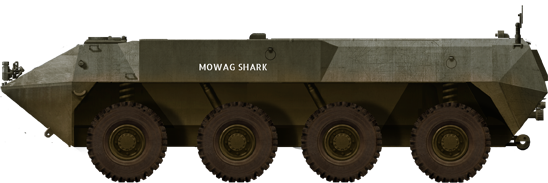
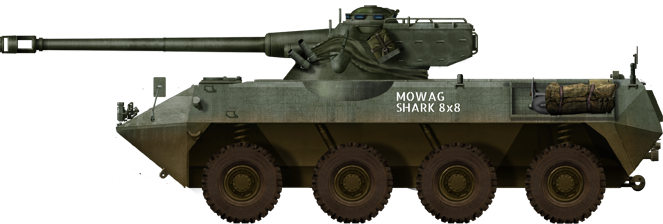
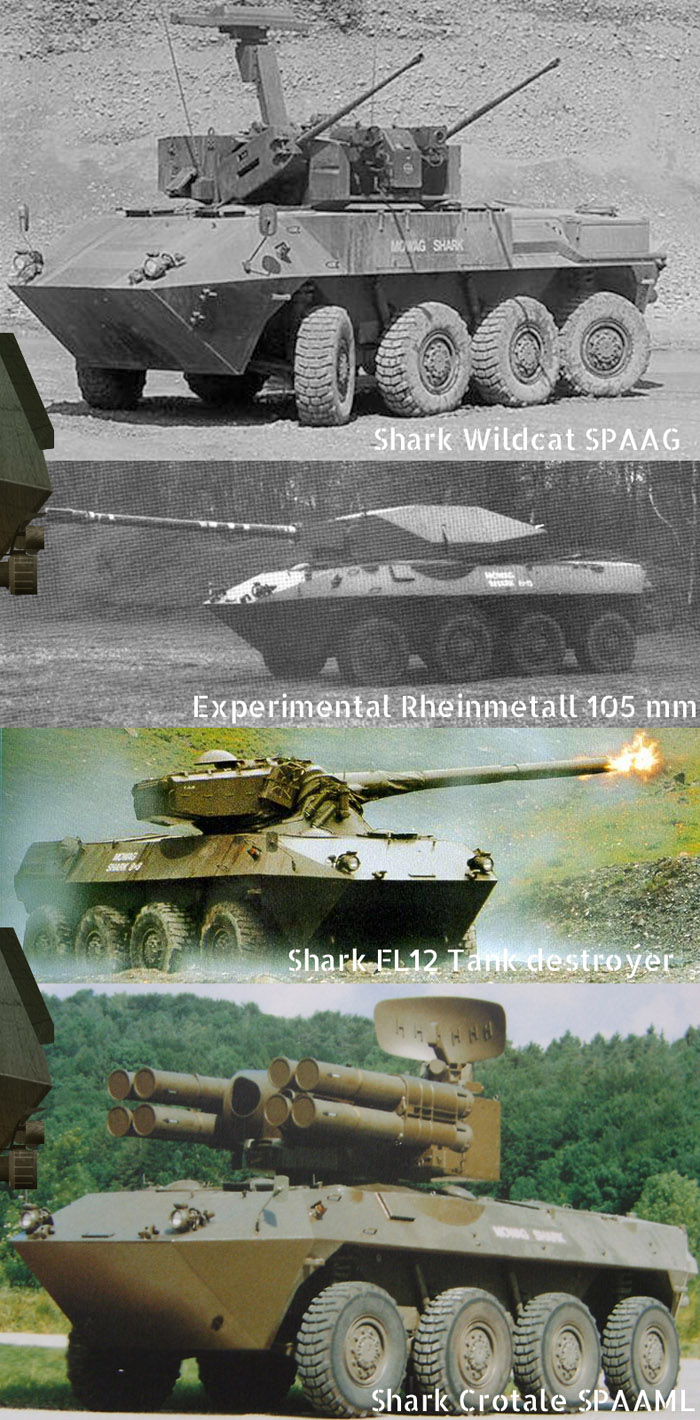
The four main versions of the Shark.
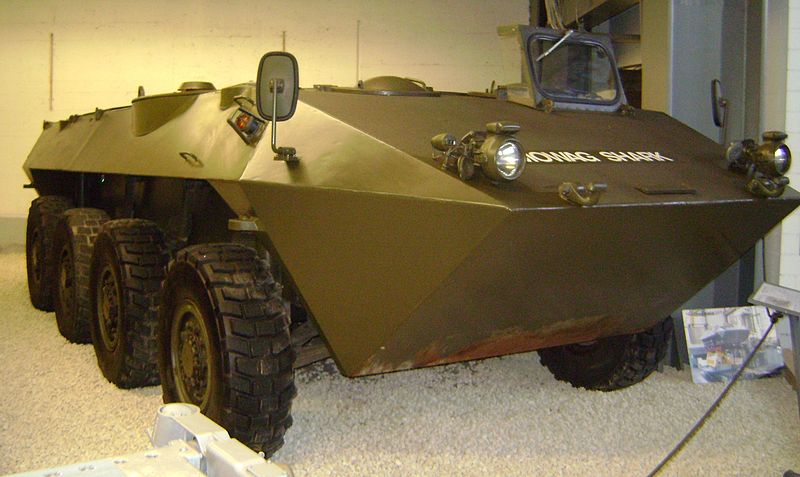





Read More
Marcus Bauer, Nutzfahrzeuge der MOWAG Motorwagenfabrik AG, Fachpresse Goldach, Hudson & Company, 1996 ISBN 9783857380563 Foss, Christopher F. Jane's Armour and Artillery 1987–88. London: Jane's Yearbooks, 1987. ISBN 0-7106-0849-7 Militärmuseum Full Switzerland Christopher F. Foss (Hrsg.): Jane's Armour and Artillery, 1987–88. (= Jane's Yearbooks). 8th edition. Jane's, London u. a. 1987, ISBN 0-7106-0849-7. Marcus Bauer: Nutzfahrzeuge der MOWAG Motorwagenfabrik AG, Fachpresse Goldach, Kreuzlingen 1996, ISBN 978-3-85738-056-3.
Cold War Tanks


































Cold war tanks posters

Cold War Main Battle Tanks

Cold War Soviet Army
Museums, Movies, Books & Games
The Tanks and Armor in pop culture
Tanks and armored vehicles in general are only really grasped when seen first person: The mass, the scale, it's all there. Explore also the way tanks were covered in the movie industry, in books and in video games.Movies:
Best tanks movie on warhistoryonline.com
On imdb.com
On bestsimilar.com/
miltours.com
liveabout.com/
watchmojo.com
Video Games:
pcgamesn.com
historyhit.com
levvvel.com
vg247.com/best-tank-games
mmobomb.com/
alienwarearena.com


